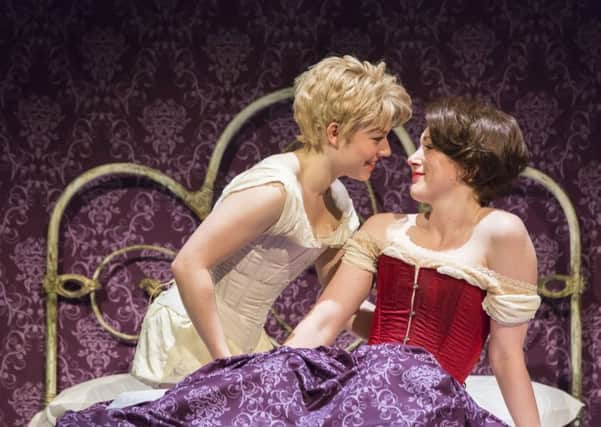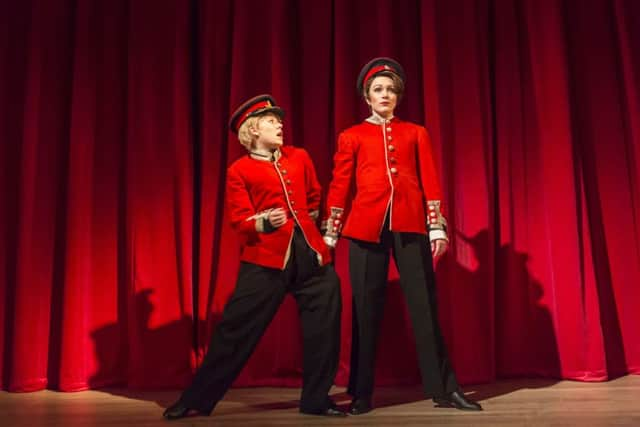Tipping The Velvet’s Laura Wade on handling play’s sex scenes


LAURA Wade would rather I didn’t tell you about the sex. It’s not that the playwright is prudish. If that had been the case, she would never have gone near Tipping The Velvet, with its portrayal of London’s Victorian lesbian scene (leather dildos, back-alley prostitution, cross-dressing and all), let alone adapted it for the stage.
No, Wade’s issue is not with the sex in Sarah Waters’ debut novel, but with the way it’s represented on stage. She wants it to be a surprise. “It’s a really nice reveal moment,” she says.
Advertisement
Hide AdLet’s just say, then, that the sex scenes in Lyndsey Turner’s production are neither raucous nor explicit. Rather, they are theatrically stylised.


“It felt important to tell those sex moments in a way that properly conveyed what that sexual encounter felt like, rather than what it looked like,” says Wade. “The different emotional character of those encounters is important to the story.”
Being theatrically stylised is in keeping with a novel that has performance at its core. Published in 1998, it is the coming-of-age story of Nancy Astley, daughter of a family of Whitstable oyster sellers, who falls in love with Kitty Butler, a male impersonator whom she watches night after night in a Canterbury music hall.
In time, Nancy becomes dresser, lover and co-star of the entertainer, whose gentlemanly stage outfits allow her to hide her true nature in plain sight. The male clothes Nancy and Kitty wear in their act are no less of a disguise than the image of maidenly respectability they must project in day-to-day life.
“Even when she’s left the theatre professionally, Nancy is still performing herself,” says Wade. “She is working towards finding an authentic version of herself, whether professionally or in terms of her sexuality.”


That sexuality is underrepresented on the stage. Stories of heterosexual relationships and, to a lesser extent, male homosexuality are commonplace, but that’s not the case with lesbian relationships. It’s one reason Tipping The Velvet stands out from the crowd. “The beautiful thing about Sarah’s book is that the sexuality of the characters is taken for granted,” says Wade. “It isn’t agonised over, it’s normalised. Nancy’s sexual awakening is a natural thing for her. The world of Victorian lesbians that Sarah takes us into is as varied as the world of any other sexuality.”
Advertisement
Hide AdThe show, which opened at London’s Lyric Hammersmith last month before its run in Edinburgh, is the result of Wade’s close working relationship with Lyndsey Turner, director of the recent Benedict Cumberbatch Hamlet. The two have collaborated before: on Alice, a Lewis Carroll reworking; and on Posh, inspired by Oxford University’s elitist Bullingdon Club, which Wade later adapted for the big screen as The Riot Club.
Having the director involved from the start gave her the confidence to tell the story with a theatrical flourish, making use of songs, music-hall gags and direct audience address, not to mention a 14-strong ensemble.
Advertisement
Hide Ad“The way we work is the best idea wins – and there isn’t any ego in that,” she says. “Nothing’s too stupid to suggest because even if it’s ridiculous, it can lead on to a better idea. Lyndsey is great at making sure everything is as theatrical, active and alive as we need it to be.”
The greatest challenge in adapting the book, she says, was how to turn the first-person narrative of the page into the multiple perspectives of the stage. It meant identifying the spirit of the original while reimagining the story afresh. Her task was to be faithful to the author’s intent without being hidebound by the detail. If that meant skipping through dozens of pages with a single line or giving new prominence to a previously small detail, then so be it.
It was an approach given the seal of approval by Waters herself. “She’s been hugely supportive and positive,” says the playwright, who chose not to watch the 2002 TV adaptation, starring Rachael Stirling and Keeley Hawes, so as to tackle the material in a fresh way. “She was beautifully present when we needed her to be, but there was no helicopter parenting going on; she wasn’t hovering. She’s a great lover of the theatre and so her understanding of it as a form really helped. She knew we needed to take a bold approach.”
A case in point is the play’s master of ceremonies – known as the chairman. In the novel, he is a minor character who keeps things ticking along in the Canterbury music hall. Here, he becomes a linchpin of the show, welcoming us into the theatre and guiding us through the production. “When Sarah read the first draft, she was hugely positive about the idea of the chairman character,” says Wade. “In the book, approximately a sentence describes him, but she loved the theatricality of drawing him out and making him a big part of how the show works.”
She adds: “I always feel with adaptations that you have to acknowledge the difference between the media. A book and a play work very differently. With the first third of the book having such a theatrical setting, it seemed a very natural way to go with it. As we worked on it, the idea of giving it a music-hall structure seemed like an exciting way of presenting that same story. It was to find a theatrical idiom for it that also would chime with the way that Nancy’s mind worked.”
The theatricality extends to Michael Bruce’s score, a curious hybrid of modern-day pop and old-time variety. If you’ve ever wondered how Nancy Sinatra, Bronski Beat and Miley Cyrus would have sounded a century before their time, then wonder no more. “A Victorian music hall audience would go often and would know the songs that they were seeing on stage,” says Wade. “Everything would have that recognition factor. We wanted to create that kind of feeling for a modern audience and we thought there was a joy to be found in using modern songs and giving them a music-hall twist.”
Twitter: @MarkFFisher
• Tipping The Velvet is at the Royal Lyceum, Edinburgh, from Wednesday until 14 November, www.lyceum.org